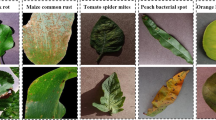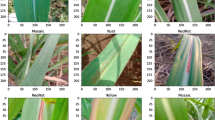Abstract
Automatic identification of plant diseases is critical for agricultural crop protection so as to enhance the crop yield. The recent advances in deep learning and image processing gives hope for the development of efficient algorithms to address this issue. In this manuscript, we make use of these schemes to develop a Light-Weight Convolutional Neural Network (LWCNN) for identifying diseases in the leaves and ears of pearl millets. Although many models exist in the literature, the total number of parameters employed by our model is far fewer, by an order of thousand as compared to many other light-weight networks such as MobileNet(v2), EfficientNet, NASNet etc. Hence our scheme can be employed and run directly on devices with much lesser compute power. It is noteworthy that despite using few parameters, the proposed model achieves an accuracy of 97.4% in detecting the existence of the downy mildew disease in pearl millets, and takes the least time for both training and testing as compared to other models. To eliminate most of the pre-processing steps and to make our system suitable for on-field detection, we explore three single stage object detectors namely SSD, YOLOv3 and RetinaNet which localize and classify multiple instances of healthy and diseased leaves and ears in the image. We present a comparative analysis of the models and our experiments indicate that SSD is most suitable outperforming the other two models by a significant margin.








Similar content being viewed by others
References
Akhtar A, Khanum A, Khan SA, Shaukat A (2013) Automated plant disease analysis (apda): Performance comparison of machine learning techniques. In: 11th International Conference on Frontiers of Information Technology, 2013, pp 60–65
Amara J, Bouaziz B, Algergawy A (2017) A deep learning-based approach for banana leaf diseases classification. In: BTW, pp 79-88
Boulent J, Foucher S, Th´eau J, St-Charles P-L (2019) Convolutional neural networks for the automatic identification of plant diseases. Front Plant Sci 10:941, [Online]. Available: https://www.frontiersin.org/article/https://doi.org/10.3389/fpls.2019.00941
Cheng X, Zhang Y, Chen Y, Wu Y, Yue Y (2017) Pest identification via deep residual learning in complex background. Comput Electron Agric 141:351–356
Coulibaly S, Kamsu-Foguem B, Kamissoko D, Traore D (2019) Deep neural networks with transfer learning in millet crop images. Comput Ind 108:115–120, [Online]. Available: https://hal.archives-ouvertes.fr/hal-02104287
Es-saady Y, El Massi I, El Yassa M, Mammass D, Benazoun A (2016) Automatic recognition of plant leaves diseases based on serial combination of two svm classifiers. In: International Conference on Electrical and Information Technologies (ICEIT), 2016, pp 561–566
Ferentinos KP (2018) Deep learning models for plant disease detection and diagnosis. Comput Electron Agric 145:311–318, [Online]. Available: http://www.sciencedirect.com/science/article/pii/S0168169917311742
Jiang P, Chen Y, Liu B, He D, Liang C (2019)Real-time detection of apple leaf diseases using deep learning approach based on improved convolutional neural networks. IEEE Access 7(080):069–059
Kale AP, Sonavane SP (2019) Iot based smart farming: Feature subset selection for optimized high-dimensional data using improved ga based approach for elm. Computers and Electronics in Agriculture 161:225–232. bigData and DSS in Agriculture
Liakos K, Busato P, Moshou D, Pearson S, Bochtis D (2018) Machine learning in agriculture: A review. Sensors 18(8):2674, 08 [Online]. Available: https://doi.org/10.3390/s18082674
Lin T-Y, Goyal P, Girshick R, He K, Doll´ar P (2017) Focal loss for dense object detection. IEEE International Conference on Computer Vision (ICCV), Venice, Italy, pp 2999-3007
Liu W, Anguelov D, Erhan D, Szegedy C, Reed S, Fu C-Y, Berg AC (2016) Ssd: Single shot multibox detector. In: Computer Vision – ECCV 2016. Leibe B, Matas J, Sebe N, Welling M (ed). Springer International Publishing, Cham, pp 21–37
Lu Y, Yi S, Zeng N, Liu Y, Zhang Y (2017) Identification of rice diseases using deep convolu- tional neural networks. Neurocomputing 267:07
Mao Q, Sun H, Liu Y, Jia R (2019) Mini-yolov3: Real-time object detector for embedded applications. IEEE Access 7(538):529–133
Mohanty SP, Hughes DP, Salath´e M (2016) Using deep learning for image-based plant disease detection. Front Plant Sci 7:1419, [Online]. Available: https://www.frontiersin.org/article/https://doi.org/10.3389/fpls.2016.01419
Ning X, Li W, Liu W (2017) A fast single image haze removal method based on human retina property. IEICE Trans Inf Syst 100–D:211–214
Ning X, Duan P, Li W, Zhang S (2020)Real-time 3d face alignment using an encoder-decoder network with an efficient deconvolution layer. IEEE Signal Process Lett 27:1944–1948
Ramcharan A, Baranowski K, McCloskey P, Ahmed B, Legg J, Hughes DP (2017) Deep learning for image-based cassava disease detection. Front Plant Sci 8:1852, [Online]. Available: https://www.frontiersin.org/article/https://doi.org/10.3389/fpls.2017.01852
Redmon J, Farhadi A (2018) YOLOv3: An Incremental Improvement. arXiv:1804.02767 [cs], Apr. arXiv: 1804.02767. [Online]. Available: http://arxiv.org/abs/1804.02767
Saleem P, Arif M (2019) Plant disease detection and classification by deep learning. Plants 8(11):468, 10 [Online]. Available: https://doi.org/10.3390/plants8110468
Sandler M, Howard AG, Zhu M, Zhmoginov A, Chen L (2018) “Mobilenetv2: Inverted residuals and linear bottlenecks,” in 2018 IEEE Conference on Computer Vision and Pattern Recognition, pp. 4510–4520
Selvaraju RR, Cogswell M, Das A, Vedantam R, Parikh D, Batra D (2020) Grad-CAM: Visual Explanations from Deep Networks via Gradient-based Localization. Int J Comput Vis 128(2):336–359, Feb. arXiv: 1610.02391. [Online]. Available: http://arxiv.org/abs/1610.02391
Singh V, Misra A (2017) Detection of plant leaf diseases using image segmentation and soft computing techniques. Inf Process Agric 4(1):41–49
Singh SD, King SB, Werder J (1993). Downy mildew disease of pearl millet. Information Bulletin no. 37. (In En. Summaries in Fr, Es.) Patancheru, A.P. 502 324, India: International Crops Research Institute for the Semi-Arid Tropics, pp 36
Tan M, Le QV (2019) Efficientnet: Rethinking model scaling for convolutional neural networks, International Conference on Machine Learning, pp. 6105-6114
Wang H, Li G, Ma Z, Li X (2012) Image recognition of plant diseases based on principal component analysis and neural networks. In: 8th International Conference on Natural Computation, pp. 246–251
Wolfert S, Ge L, Verdouw C, Bogaardt M (2017) Big data in smart farming – a review. Agric Syst 153:69–80
Xin N, Pengfei D, Weijun L, Yuan S, Shuang L (2020) A cpu real-time face alignment for mobile platform. IEEE Access 8:8834–8843
Zoph B, Vasudevan V, Shlens J, Le QV (2018) "Learning Transferable Architectures for Scalable Image Recognition," 2018 IEEE/CVF Conference on Computer Vision and Pattern Recognition, pp. 8697-8710. https://doi.org/10.1109/CVPR.2018.00907
Acknowledgements
The authors thank the DST SYST for funding this research work (Project Grant File No: SP-YO- 688-2018). The authors also thank Dr, Praveen Gehlot and Dr. Manoj Kumar for their assistance in plant pathology and data acquisition and Mr. Hiren for his assistance in image acquisition and segmentation.
Funding
This research was funded by DST-SYST (Scheme for Young Scientists and Technologist) funding, under Project Grant File No: SP-YO-688-2018.
Author information
Authors and Affiliations
Corresponding author
Additional information
Publisher’s Note
Springer Nature remains neutral with regard to jurisdictional claims in published maps and institutional affiliations.
Rights and permissions
About this article
Cite this article
Raman, S., Soni, M., Ramaprasad, R. et al. LWCNN: a lightweight convolutional neural network for agricultural crop protection. Multimed Tools Appl 81, 22323–22334 (2022). https://doi.org/10.1007/s11042-021-11866-0
Received:
Revised:
Accepted:
Published:
Issue Date:
DOI: https://doi.org/10.1007/s11042-021-11866-0




